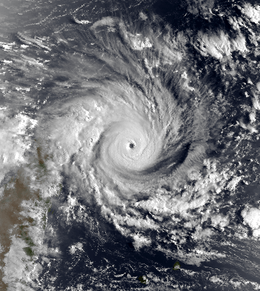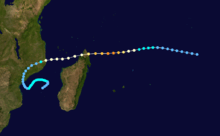Cyclone Nadia
| Intense tropical cyclone (SWIO scale) | |
|---|---|
| Category 4 (Saffir–Simpson scale) | |
 Cyclone Nadia near peak intensity on March 22 | |
| Formed | March 16, 1994 |
| Dissipated | April 1, 1994 |
| Highest winds |
10-minute sustained: 175 km/h (110 mph) 1-minute sustained: 220 km/h (140 mph) |
| Lowest pressure | 925 hPa (mbar); 27.32 inHg |
| Fatalities | 252 total |
| Damage | $20.2 million (1994 USD) |
| Areas affected | Madagascar, Mozambique, Malawi |
| Part of the 1993–94 South-West Indian Ocean cyclone season | |
Cyclone Nadia was a powerful tropical cyclone that struck both Madagascar and Mozambique in March 1994. It formed on March 16 and moved westward for the first ten days of its duration. Warm waters and low wind shear allowed for the storm to gradually strengthen. After developing a well-defined eye, Nadia intensified to reach winds of 175 km/h (110 mph 10 minute sustained) early on March 22, according to Météo-France (MF). In contrast, the Joint Typhoon Warning Center (JTWC) estimated winds of about 220 km/h (140 mph 1 minute sustained). On March 23, the cyclone struck northern Madagascar, causing flooding and localized damage where it moved ashore. There were 12 deaths in the country. Nadia emerged into the Mozambique Channel as a weakened storm, although it reintensified slightly before making landfall in northeastern Mozambique on March 24. The storm turned southward through the country, emerging over water on March 26. It turned to the northeast and meandered over waters before dissipating on April 1.
Damage was heaviest in Mozambique, estimated at about $20 million (1994 USD). Cyclone Nadia severely affected four provinces in the country, primarily Nampula Province where it moved ashore. There, 85% of the houses were destroyed, and across its path, the cyclone left 1.5 million people homeless. High winds caused widespread power outages, left areas without water, and significantly damaged crops, notably the cashew crop. The storm struck before the harvest, and lack of food resulted in 300 deaths in the months after the storm. Across Mozambique, Nadia directly caused 240 deaths and injured thousands. Effects spread as far inland as Malawi.
Meteorological history

A disturbance in the Indian Ocean intertropical convergence zone became evident southeast of the Chagos Archipelago on March 16 after two cyclones moved away from the region. Based on analysis from MF, the system slowly organized while moving westward, its movement influenced by a subtropical ridge to the south.[1] On March 17, the JTWC also began tracking the system.[2] Due to cool, dry air, the system initially did not intensify, although its passage over warmer sea surface temperatures on March 19 allowed for strengthening. On March 19, MF classified the disturbance as Tropical Storm Nadia after rainbands developed.[1] A day later, the JTWC designated Nadia as Tropical Cyclone 23S.[3]
After becoming a tropical storm, Nadia quickly intensified, developing a central dense overcast and later an eye. With minimal wind shear, the storm strengthened into a tropical cyclone early on March 21.[1] That day, the JTWC estimated winds of 120 km/h (75 mph 1-minute sustained), or the equivalent of a minimal hurricane,[2] and late on March 21, MF upgraded Nadia into an intense tropical cyclone.[1] While the cyclone was approaching northern Madagascar on March 22, MF estimated Nadia attained maximum sustained winds of 175 km/h (110 mph 10 minute sustained) early on March 22.[4] At around the same time, the JTWC estimated winds of about 220 km/h (140 mph (1-minute sustained)).[2] While at peak intensity, Nadia had well-defined outflow and an eye no larger than 30 km (19 mi). At about 0100 UTC on March 23, Nadia made landfall on northern Madagascar near Vohemar, having weakened slightly from its peak.[1]
While located over Madagascar, Nadia weakened into a tropical storm due to the mountainous terrain. With warm temperatures, the storm re-intensified slightly after entering the Mozambique Channel, and it passed about 100 km (62 mi) south of Mayotte at 1900 UTC on March 23. At 1700 UTC the next day, Nadia made its second landfall on Mozambique, about halfway between Nacala and Moçambique.[1] Shortly thereafter, the JTWC discontinued advisories.[3] Despite moving further inland, Nadia retained a well-organized circulation and convection. The storm turned to the south and re-emerged into the Mozambique Channel late on March 26 near the mouth of the Zambezi River. Nadia gradually re-intensified while curving to the southeast, and it re-intensified into a tropical storm on March 28,[1] the same day the JTWC resumed issuing advisories.[3] The storm strengthened to reach a secondary peak intensity of 85 km/h (50 mph (10 minute sustained)), according to MF. After reaching a position about halfway between Mozambique and Madagascar, Nadia turned to the southwest on April 1 and lost its remaining convection.[1] The JTWC and MF discontinued advisories that day, and the circulation dissipated a day later.[1][3]
Impact and aftermath

While crossing northern Madagascar, Nadia produced widespread flooding. In Vohemar where it moved ashore, the storm destroyed most public buildings, although local churches provided assistance in the aftermath.[5] Across the region, the storm downed power lines and destroyed more than 540 tonnes (600 tons) of rice.[6] The cyclone killed 12 people and caused about $200,000 damage (1994 USD).[7]
Upon striking Mozambique, Nadia produced heavy rains and strong wind gusts, causing widespread tree damage and flooding.[8] The city of Nampula recorded 126 mm (4.96 in) of rainfall in a 24‑hour period.[9] Damage was heaviest in Nampula, Zambezia, Manica, and Sofala provinces.[8] In Nampula Province, Nadia destroyed 85% of the houses and 75% of the crops, mostly cashew trees. The city of Nacala was heavily damaged,[1] with about 170,000 people losing their houses. Many residents evacuated Nacala, and temporary shelters were provided for those who stayed. At the port in Nacala, the local harbor was wrecked and two ships sank;[8] one of the damaged ships spilled oil into the Bay of Nacala.[10] The city lost power and water, and its primary hospital was destroyed. About 130 km (81 mi) of power lines were cut between Nampula and Nacala, and widespread road and bridge damage disrupted transportation. In the area along Nadia's path, over 120 schools were damaged destroyed, affecting over 46,864 students.[8] Across the country, roughly 1.5 million people were left homeless.[11] A World Food Programme building in the city was destroyed, wrecking 642 tonnes (708 tons) of stored food. Overall, Nadia killed 240 people in Mozambique and injured thousands.[8] Damage was estimated at $20 million (1994 USD).[12]
Damage from Nadia extended as far inland as Malawi.[13]
After the storm, about 300,000 people in Nampula Province in Mozambique required food and other goods. Officials sent relief to the affected areas, including iron sheeting and medical teams. Due to damage to sanitation facilities, there were outbreaks of diarrhea and cholera in the weeks after the storm. By April 20, most primary roads were cleared, bridge reconstruction had commenced, and power was being restored. Heavy crop damage depleted food supplies,[8] The cyclone struck shortly before the annual harvest,[12] causing heavy crop damage that depleted food supplies.[8] Some residents who evacuated during the country's civil war returned late to assist in harvesting the remaining crops. In the six months after the storm, about 300 people died due to starvation.[12] Many secondary roads remained blocked in the weeks after the storm, forcing relief supplies to be transported by boat.[8] The country appealed to the international community for assistance, and by Mary 6, various international agencies and governments donated about $1.4 million in cash (1994 USD). The French government sent $48,000 worth of medicine, blankets, and food, the United Kingdom sent $373,134 for generators, water tanks, and roofing materials, and the Spanish government sent about $117,000 worth of food and tents. The charity organization Concern Worldwide sent 54,000 sets of clothing to the country. The government of Japan sent 6,000 blankets and 1,800 bars of soap, while the Italian government sent five generators, eight water tanks, and 1,150 agricultural tools. Donated generators assisted in restoring water in Nacala.[8] In June 1994, the World Bank provided $20 million in assistance to the country due to the storm.[14] Cyclone Nadia contributed to fishing exports decreasing by $11 million during the year.[15]
See also
References
- 1 2 3 4 5 6 7 8 9 10 Guy Le Goff (1994). "1993–1994 Cyclone Season in the South-West Indian Ocean". Météo-France. pp. 75–76. Retrieved 2012-08-11.
- 1 2 3 Joint Typhoon Warning Center. "Tropical Cyclone 23S (Nadia) best track analysis". United States Navy, United States Air Force. Retrieved 2012-08-11.
- 1 2 3 4 Joint Typhoon Warning Center; Naval Pacific Meteorology and Oceanography Center. Chapter 4 — Summary of South Pacific and South Indian Ocean Tropical Cyclones (PDF) (1994 Annual Tropical Cyclone Report). United States Navy, United States Air Force. p. 246. Retrieved July 27, 2013.
- ↑ "Donnees De Nadia" (in French). Météo-France. 2004. Retrieved 2012-08-11.
- ↑ Jane Scobie (1996). Mitigating the Millennium. Intermediate Technology. p. 55. ISBN 978-0-7881-7465-0. Retrieved 2012-08-26.
- ↑ "Five killed by cyclone in Madagascar". United Press International. 1994-03-25.
- ↑ EM-DAT: The OFDA/CRED International Disaster Database (2009). (Report). Université Catholique de Louvain, Brussels (Belgium) http://www.emdat.be/. Retrieved 2012-08-12. Missing or empty
|title=(help) - 1 2 3 4 5 6 7 8 9 UN Department of Humanitarian Affairs (1994). Mozambique: Cyclone Mar 1994 UN DHA Situation Reports 1 - 8 (Report). ReliefWeb. Retrieved 2012-08-12.
- ↑ Jack Beven. "Tropical Cyclone Weekly Summary #138 (March 20 - 27, 1994)". Retrieved 2012-08-12.
- ↑ Kenya News Agency (1994-04-05). "Ships damaged by Cyclone Nadia threaten to pollute Bay of Nacala". British Broadcasting Corporation.
- ↑ OFDA Annual Report FY 1994 (PDF) (Report). Office of United States Foreign Disaster Assistance. p. 28. Retrieved 2012-08-12.
- 1 2 3 International Organisation for Migration (1996). Health impact of large post-conflict migratory movements: The experience of Mozambique (PDF) (Report). p. 63. Archived from the original (PDF) on 2013-11-13. Retrieved 2012-08-12.
- ↑ "Natural Disasters in Africa". International Perspectives on Natural Disasters: Occurrence, Mitigation, and Consequences. Netherlands: Kluwer Academic Publisher. 2004. p. 239. ISBN 1-4020-2850-4. Retrieved 2012-08-12.
- ↑ "World Bank credit to Mozambique formalised". Agence France-Presse. 1994-06-21.
- ↑ "Fishing industry exports decline in 1994". British Broadcasting Corporation. 1995-03-21.
External links
- Joint Typhoon Warning Center (JTWC).
- Météo France (RSMC La Réunion).
- World Meteorological Organization